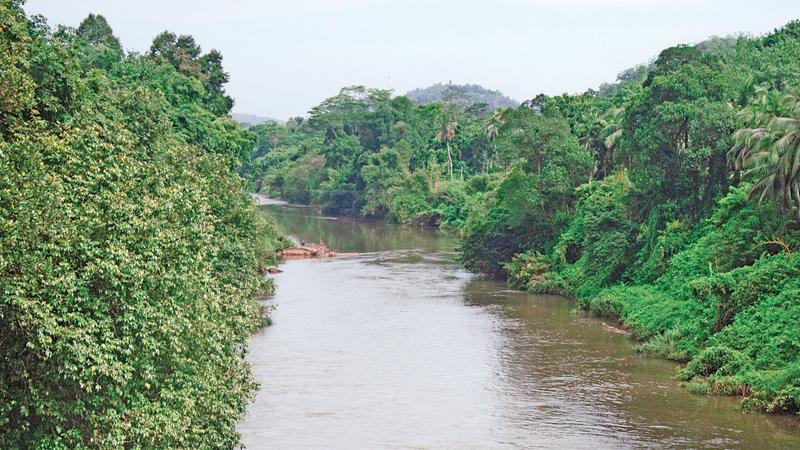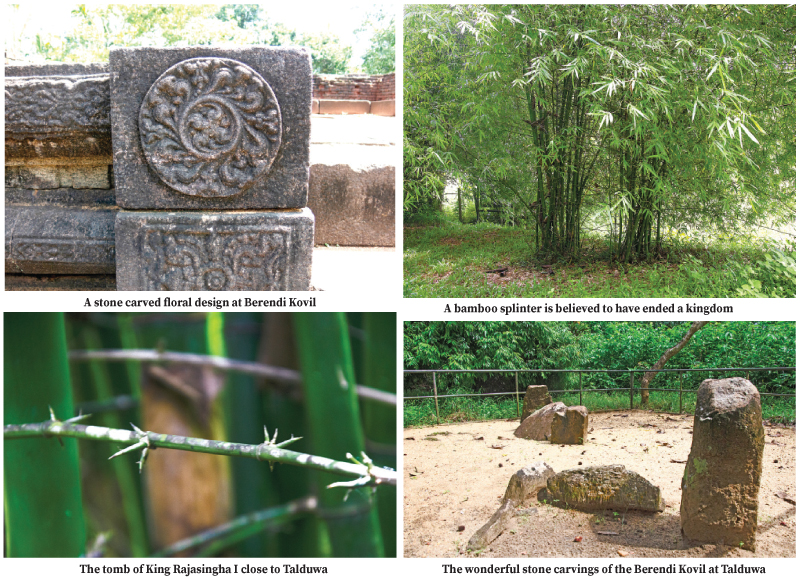A lost Kingdom – by MAHIL WIJESINGHE
 source:-Sunday observer
source:-Sunday observer
The Sitawaka Ganga flows through Talduwa
Visiting the ruins of the Sitawaka Kingdom scattered in the vicinity of Avissawella had long been in my bucket list. If you wish to explore on a historic note, I suggest a tour around the 16th century medieval Kingdom of Sitawaka. A bonus being that it is only a 11/2-hour journey from Colombo and is an ideal day’s visit. However, be not disappointed for little remains today of the Kingdom of Sitawaka whose first king was Mayadunne, followed by his illustrious son, Rajasingha I.
The brave exploits of King Rajasingha I, have been documented in the Rajawaliya chronicle where he is hailed as the ‘King of Lions’. The Rajawaliya pays tribute to the young Prince Tikiri Bandara (as he was named then) who valiantly fought alongside his father King Mayadunne to defeat the Portuguese and vanquished all other enemies. It also records that he united ‘the illustrious Lanka under one royal banner’, and thereafter took the name Prince Rajasingha.
Berendi Kovil
I jumped at the opportunity when my son offered to organise a day’s visit a couple of weeks ago. Although I had visited the Berendi Kovil on several occasions, I never visited other places of interest in the Sitawaka Kingdom such as, the Pethangoda Uyana, the tomb stone of Rajasingha I, the ruins of the Sitawaka fort and the palace of King Rajasingha I.
King Rajasingha I, who had his capital at Sitawaka during the period (1578-1597) AD, is recorded in history as a warrior who had kept the Portuguese at bay and fought his own opponents within the country.
This King met his death at Pethangoda when he was pricked by a poisonous bamboo thorn on his return after war with Konappu Bandara who later ascended the Kandyan throne as King Vimaladharmasuriya I in Kandy. The king retreated to the royal park at Pethangoda, and here a fatal bamboo splinter ran into his foot. It is believed that his body was brought along the Gurugoda Oya, Kelani Ganga and Sitawaka Ganga and interred at a place close to Talduwa. The tomb in his memory can be identified by an enclosure erected by the Department of Archaeology and lacks any elegance worthy of a ruler. This was due to the fact the he was considered a patricide as the legend says.
Pethangoda, where the king met with his death, has been identified as a place five kilometres beyond the bridge across Gurugoda Oya close to Anguruwella on the Avissawella-Kegalla road in Ruwanwella.
My first stop was the tomb of Rajasingha I. Along the Avissawella-Amithirigala road, a familiar Archaeological Department board made us stop at the burial ground of the mighty Rajasinghe I of Sitawaka fame, the King of Lions.
Disappointingly, a few granite stones enclosed by an iron railing marked his grave. This site like most of the stories related to King Rajasingha I is subject to debate. A huge star fruit tree nearby invited us to share its abundance. At the tomb stone, I was alternating between photographing monuments in the bright late morning light and listening to the long sing-song historical narrative of birds at the site.
Bamboo groves
Our next stop was the Pethangoda bamboo grove which can be reached along the Avissawella-Ruwanwella -Kegalla road, located in a wooded village with lush greenery.
Whatever the reason for his death, two humongous bamboo groves growing separate but close to each other and protected by barbed wire fence are preserved to this date to commemorate the King’s life story. Most peculiar is the grove of thorns that spike from the shoots. Some thorns are as much as three feet long and from which smaller and sharper thorns spike. Unfortunately, these two massive bamboo groves have been completely destroyed due to natural elements. Villagers told us that a parasite infected the groves and caused its end a few years ago.
However, two small bamboo groves are now growing at the site with the same thorny spikes. The setting couldn’t be more idyllic. On one side of the bamboo grove stretched cultivated lands while on all other sides it seemed to be rubber. Although two concrete benches had been put up to sit and enjoy the environ by visitors in the past, the place has now been overgrown with weeds and completely neglected.
After visiting Pethangoda, we came back to Talduwa on the Avissawella road to visit Berendi Kovil. We were quite taken aback at some of the elaborate and wonderful stone designs that decorated the ruins of the Berendi Kovil which is one of the magnificent relics of the remaining ruins of the Sitawaka Kingdom. As we walked through the gate installed by the Archaeological Department, we could see three distinct terraces built upon each other. This Kovil can be reached along the road between Avissawella and Talduwa.
Across the Sitawaka Ganga is the Berendi Kovil, built by King Rajasingha I (1578-1597) to try to waylay divine retribution for his dual crimes of patricide and murdering bhikkhus (by burying them up to their necks in a field and plowing their heads off).
Looking at the stone carvings, the architectural features of the building depict a happy blending of Hindu architecture with those of the local traditions. King Rajasingha I, a Buddhist by birth, later converted to Hinduism and built many Hindu temples. The finest, Berendi Kovil dedicated to Shiva, was instrumental in getting kovils erected.
The Kovil is rectangular in appearance. A canal paved with stone connects the Kovil to the Sitawaka Ganga, the uppermost level of which had accommodated the Kovil. In place of ornate carvings found in South Indian Hindu temples, smooth architectural carvings have been used showing the blending of the South Indian tradition with those of the local.
This shrine had been designed on the guidance of the Hindu priest, Arittakivendu Perumal, who was credited with having converted the King to Hinduism. Sadly, the Berendi Kovil was destroyed by the Portuguese. But the ruins tell a tale of a grand Kovil that stood on the bank of the Sitawaka Ganga.
The adjoining fort and palace, said to have been destroyed by the Portuguese, overlooked the Berendi Kovil on the opposite bank of the Sitawaka Ganga.
The ruins have been identified at Bandarawatte, by the side of the Avissawella – Panawala road near Dehiowita. Having explored the ruins, we ended our day’s trip to bid goodbye to the Kingdom of Sitawaka just for the day.









No Comments